Rio Tinto (corporation)
Rio Tinto Group is an Anglo-Australian multinational and the world's second largest metals and mining corporation, behind BHP, producing iron ore, copper, diamonds, gold and uranium.[4][5] The company was founded in 1873, when a multinational consortium of investors purchased a mine complex on the Rio Tinto, in Huelva, Spain, from the Spanish government. Since then, the company has grown through a long series of mergers and acquisitions to place itself among the world leaders in the production of many commodities, including aluminium, iron ore, copper, uranium, and diamonds.[6] Although primarily focused on extraction of minerals, Rio Tinto also has significant operations in refining, particularly for refining bauxite and iron ore.[7] Rio Tinto has joint head offices in London (global and "plc") and Melbourne ("Limited" – Australia).[8][9]
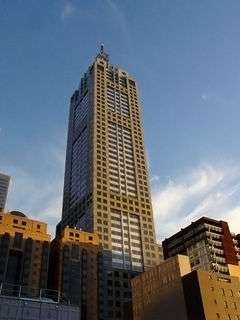 | |
| Dual-listed company | |
| Traded as | ASX: RIO LSE: RIO NYSE: RIO FTSE 100 Component |
| ISIN | GB0007188757 |
| Industry | Metals and Mining |
| Founded | 1873 |
| Headquarters | London, United Kingdom (Global headquarters & Rio Tinto Plc) Melbourne, Australia (Rio Tinto Limited) |
Area served | Worldwide |
Key people |
|
| Products | Iron ore, Bauxite, Alumina, Aluminium, Copper, Molybdenum, Gold, Diamonds, Uranium, Titanium Dioxide, Borates, Salt, Talc |
| Revenue | |
| Total assets | |
| Total equity | |
Number of employees | 47,000 (2019)[3] |
| Divisions | Rio Tinto Alcan Kennecott Utah Copper |
| Website | www |
Rio Tinto is a dual-listed company traded on both the London Stock Exchange, where it is a component of the FTSE 100 Index,[10] and the Australian Securities Exchange, where it is a component of the S&P/ASX 200 index.[11] Additionally, American Depositary Shares of Rio Tinto's British branch are traded on the New York Stock Exchange,[2] giving it listings on a total of 3 major stock exchanges.
Formation
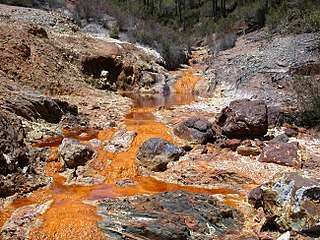
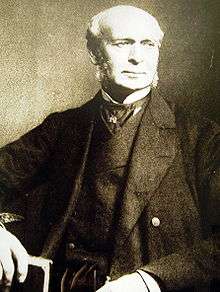
Since antiquity, a site along the Rio Tinto in Huelva, Spain has been mined for copper, silver, gold, and other minerals.[13] Around 3000 BC, Iberians and Tartessians began mining the site, followed by the Phoenicians, Greeks, Romans, Visigoths, and Moors. After a period of abandonment, the mines were rediscovered in 1556 and the Spanish government began operating them once again in 1724.[13]
However, Spain's mining operations there were inefficient, and the government itself was otherwise distracted by political and financial crises,[14] leading the government to sell the mines in 1873 at a price later determined to be well below actual value.[15] The purchasers of the mine were led by Hugh Matheson's Matheson and Company, which ultimately formed a syndicate consisting of Deutsche Bank (56% ownership), Matheson (24%), and the civil engineering firm Clark, Punchard and Company[16] (20%). At an auction held by the Spanish government to sell the mine on 14 February 1873, the group won with a bid of GB£3,680,000 (ESP 92,800,000). The bid also specified that Spain would permanently relinquish any right to claim royalties on the mine's production. Following purchase of the mine, the syndicate launched the Rio Tinto Company, registering it on 29 March 1873.[14] At the end of the 1880s, control of the firm passed to the Rothschild family, who greatly increased the scale of its mining operations.[14]:188
Operating history
Following their purchase of the Rio Tinto Mine, the new ownership constructed a number of new processing facilities, innovated new mining techniques, and expanded mining activities.[14]
From 1877 to 1891, the Rio Tinto Mine was the world's leading producer of copper.[17]

From 1870 through 1925, the company was inwardly focused on fully exploiting the Rio Tinto Mine, with little attention paid to expansion or exploration activities outside of Spain. The company enjoyed strong financial success until 1914, colluding with other pyrite producers to control market prices. However, World War I and its aftermath effectively eliminated the United States as a viable market for European pyrites, leading to a decline in the firm's prominence.[14]
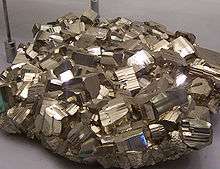
The company's failure to diversify during this period led to the slow decline of the company among the ranks of international mining firms. However, this changed in 1925, when Sir Auckland Geddes succeeded Lord Alfred Milner as chairman. Geddes and the new management team he installed focused on diversification of the company's investment strategy and the introduction of organizational and marketing reforms. Geddes led the company into a series of joint ventures with customers in the development of new technologies, as well as exploration and development of new mines outside of Spain. Between 1925 and 1931, Geddes recruited two directors: JN Buchanan (finance director) and RM Preston (commercial director), as well as other executives involved with technical and other matters.[14]
Perhaps most significant was the company's investment in copper mines in Northern Rhodesia, later Zambia, which it eventually consolidated into the Rhokana Corporation.[14] These and later efforts at diversification eventually allowed the company to divest from the Rio Tinto mine in Spain. By the 1950s, Franco's nationalistic government had made it increasingly difficult to exploit Spanish resources for the profit of foreigners.[14] Rio Tinto Company, supported by its international investments, was able to divest two-thirds of its Spanish operations in 1954 and the remainder over the following years.[18]
Major mergers and acquisitions
Like many major mining companies, Rio Tinto has historically grown through a series of mergers and acquisitions.
Early acquisitions
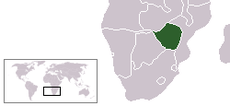
The company's first major acquisition occurred in 1929, when the company issued stock for the purpose of raising 2.5 million pounds to invest in Northern Rhodesian copper mining companies, which was fully invested by the end of 1930. The Rio Tinto company consolidated its holdings of these various firms under the Rhokana Corporation by forcing the various companies to merge.[14]
Rio Tinto's investment in Rhodesian copper mines did much to support the company through troubled times at its Spanish Rio Tinto operations spanning the Spanish Civil War, World War II, and Franco's nationalistic policies. In the 1950s, the political situation made it increasingly difficult for mostly British and French owners to extract profits from Spanish operations, and the company decided to dispose of the mines from which it took its name.[14] Thus, in 1954, Rio Tinto Company sold two-thirds of its stake in the Rio Tinto mines, disposing of the rest over the following years.[18] The sale of the mines financed extensive exploration activities over the following decade.[19]
Merger with Consolidated Zinc
The company's exploration activities presented the company with an abundance of opportunities, but it lacked sufficient capital and operating revenue to exploit those opportunities. This situation precipitated the next, and perhaps most significant, merger in the company's history. In 1962, Rio Tinto Company merged with the Australian firm Consolidated Zinc to form the Rio Tinto – Zinc Corporation (RTZ) and its main subsidiary, Conzinc Riotinto of Australia (CRA). The merger provided Rio Tinto the ability to exploit its new-found opportunities, and gave Consolidated Zinc a much larger asset base.[19]
RTZ and CRA were separately managed and operated, with CRA focusing on opportunities within Australasia and RTZ taking the rest of the world. However, the companies continued to trade separately, and RTZ's ownership of CRA dipped below 50% by 1986.[19] The two companies' strategic needs eventually led to conflicts of interest regarding new mining opportunities, and shareholders of both companies determined a merger was in their mutual best interest. In 1995, the companies merged into a dual listed company, in which management was consolidated into a single entity and shareholder interests were aligned and equivalent, although maintained as shares in separately named entities. The merger also precipitated a name change; after two years as RTZ-CRA, RTZ became Rio Tinto plc and CRA became Rio Tinto Limited, referred to collectively as Rio Tinto Group or simply Rio Tinto.[19]
Recent mergers, acquisitions, and events
Major acquisitions following the Consolidated Zinc merger included U.S. Borax, a major producer of borax, bought in 1968,[18] Kennecott Utah Copper and BP Australia's coal assets which were bought from British Petroleum in 1989, and a 70.7% interest in the New South Wales operations of Coal & Allied Industries, also in 1989.[18] In 1993, the company acquired Nerco and the United States coal mining businesses of Cordero Mining Company.[18]
In 2000, Rio Tinto acquired North Limited, an Australian company with iron ore and uranium mines, for $2.8 billion.[20] The takeover was partially motivated as a response to North Limited's 1999 bid to have Rio Tinto's Pilbara railway network declared open access.[21] The Australian Competition & Consumer Commission regulatory body approved the acquisition in August 2000,[22] and the purchase was completed in October of the same year.[23] That year, Rio Tinto also bought North Limited and Ashton Mining for US$4 billion, adding additional resources in aluminium, iron ore, diamonds, and coal.[18] In 2001, it bought (under Coal and Allied Industries) the Australian coal businesses of the Peabody Energy Corporation.[18]
On 14 November 2007, Rio Tinto completed its largest acquisition to date,[24] purchasing Canadian aluminium company Alcan for $38.1 billion,[25] as of 2014, "the largest mining deal ever completed".[26] Alcan's chief executive, Jacynthe Cote, led the new division, renamed Rio Tinto Alcan with its headquarters situated in Montreal.[27]
Activity in 2008 and 2009 was focused on divestments of assets to raise cash and refocus on core business opportunities. The company sold three major assets in 2008, raising about $3 billion in cash. In the first quarter of 2009, Rio Tinto reached agreements to sell its interests in the Corumbá iron ore mine and the Jacobs Ranch coal mine, and completed sales of an aluminium smelter in China and the company's potash operations, for an additional estimated $2.5 billion.[24]
On 5 July 2009, four Rio Tinto employees were arrested in Shanghai for corruption and espionage.[28][29] One of the arrested, Australian citizen Stern Hu, was "suspected of stealing Chinese state secrets for foreign countries and was detained on criminal charges", according to a spokesman for the Chinese foreign ministry.[30] Stern Hu was also accused of bribery by Chinese steel mill executives for sensitive information during the iron ore contract negotiations.[31][32]
On 19 March 2010 Rio Tinto and its biggest shareholder, Aluminum Corporation of China Limited (Chinalco), signed a memorandum of understanding to develop Rio Tinto's iron ore project in the Simandou mine in Simandou, Guinea.[33][34] On 29 July 2010, Rio Tinto and Chinalco signed a binding agreement to establish this joint venture covering the development and operation of the Simandou mine.[34]
Under the terms of the agreement, the joint venture maintains Rio Tinto's 95% interest in the Simandou project as follows: By providing US$1.35 billion on an earn-in basis through sole funding of ongoing development over a 2-3 year period, Chalco, a subsidiary of Chinalco, would acquire a 47% interest in the joint venture. Once the full sum was paid, Rio Tinto would be left with a 50.35% interest in the project and Chalco would have 44.65%.[35] The remaining 5% would be owned by the International Finance Corporation (IFC), the financing arm of the World Bank. On 22 April 2011 Rio Tinto, its subsidiary Simfer S.A. (Simfer), and the Guinean Government signed a settlement agreement that secured Rio Tinto's mining rights in Guinea to the southern concession of Simandou, known as blocks 3 and 4.[36] According to the agreement, Simfer would pay US$700 million and receive mining concession and government approval of the proposed Chalco and Rio Tinto Simandou joint venture.[36]
In April 2011, Rio Tinto gained a majority stake in Riversdale Mining.[37][38]
In 2011, the company rekindled its interest in potash when it entered a joint venture with Acron Group to develop the Albany potash development, in southern Saskatchewan, Canada. Following an exploration program, Acron in a June 2014 statement described Albany as "one of the best potash development opportunities in the world".[39]
On 13 December 2011, an independent arbitrator cleared the way for Rio Tinto, which had owned 49% of Ivanhoe Mines (now known as Turquoise Hill Resources), to take it over: he said the $16-billion Canadian group's "poison pill" defence was not valid. Ivanhoe had developed Oyu Tolgoi in Mongolia, one of the world's largest-known copper deposits.[40] On 28 January 2012, Rio Tinto gained control of Ivanhoe Mines and removed the management.[41]
In October 2013, Rio Tinto agreed to sell its majority stake in Australia's third-largest coal mine to Glencore and Sumitomo for a little over US$1 billion, as part of the firm's plans to focus on larger operations.[42] Less than a year later, Rio Tinto rejected two merger proposals from Glencore, proffered in July and August 2014;[26] the merger of Glencore and Rio Tinto would have created the world's largest mining company.[26]
In May 2015, Rio Tinto announced plans to sell some of its aluminium assets as part of a possible $1 billion deal, two years after a similar but failed attempt.[43]
Subsidiaries
The company has operations on six continents, but is mainly concentrated in Australia and Canada, and owns its mining operations through a complex web of wholly and partly owned subsidiaries.[24]
- Energy Resources of Australia - 68.4%
- Hathor Exploration - 100%
- QIT-Fer et Titane - 100%
- Dampier Salt - 68.4%
- Iron Ore Company of Canada - 58.7%
- Pacific Aluminum - 100%
- Palabora - 57%
- Richards Bay Minerals - 74%
- Turquoise Hill Resources - 51%
Corporate status
Rio Tinto is primarily organised into four operational businesses, divided by product type:[6]
- Aluminium – aluminium, bauxite and alumina
- Copper & Diamonds – copper and by-products such as gold, silver, molybdenum, and sulphuric acid, and the company's diamond interests
- Energy & Minerals – uranium interests, industrial minerals such as borax, salt and titanium dioxide. The corporation previously held coal production assets.
- Iron Ore
These operating groups are supported by separate divisions providing exploration and function support.[44]
Stock structure and ownership
Rio Tinto is structured as a dual-listed company, with listings on both the London Stock Exchange (symbol: RIO) under the name Rio Tinto Plc.[10] and the Australian Securities Exchange (symbol: RIO) in Sydney under the name Rio Tinto Limited[45] The dual-listed company structure grants shareholders of the two companies the same proportional economic interests and ownership rights in the consolidated Rio Tinto, in such a way as to be equivalent to all shareholders of the two companies actually being shareholders in a single, unified entity. This structure was implemented in order to avoid adverse tax consequences and regulatory burdens. To eliminate currency exchange issues, the company's accounts are kept, and dividends paid, in United States dollars.[19]
Rio Tinto is one of the largest companies listed on either exchange. As such, it is included in the widely quoted indices for each market: the FTSE 100 Index of the London Stock Exchange,[10] and the S&P/ASX 200 index of the Australian Securities Exchange.[11] LSE-listed shares in Rio Tinto plc can also be traded indirectly on the New York Stock Exchange via an American Depositary Receipt.[46] As of 4 March 2009, Rio Tinto was the fourth-largest publicly listed mining company in the world, with a market capitalisation around $134 billion.[24] As of mid-February 2009, shareholders were geographically distributed 42% in the United Kingdom, 18% in North America, 16% in Australia, 14% in Asia, and 10% in continental Europe.[24]
BHP Billiton bid
On 8 November 2007, rival mining company BHP Billiton announced it was seeking to purchase Rio Tinto Group in an all-share deal. This offer was rejected by the board of Rio Tinto as "significantly undervalu[ing]" the company. Another attempt by BHP Billiton for a hostile takeover, valuing Rio Tinto at $147 billion, was rejected on the same grounds. Meanwhile, the Chinese government-owned resources group Chinalco and the US aluminium producer Alcoa purchased 12% of Rio Tinto's London-listed shares in a move that would block or severely complicate BHP Billiton's plans to buy the company.[47][48] BHP Billiton's bid was withdrawn on 25 November 2008, with the BHP citing market instability from the global financial crisis of 2008–2009.[49]
Chinalco investment
On 1 February 2009, Rio Tinto management announced that they were in talks to receive a substantial equity infusion from Chinalco, a major Chinese state-controlled[50] mining enterprise, in exchange for ownership interest in certain assets and bonds. Chinalco was already a major shareholder, having bought up 9% of the company in a surprise move in early 2008;[51] its ownership stake had risen to 9.8% by 2014, making it Rio Tinto's biggest investor.[26] The proposed investment structure reportedly involves $12.3 billion for the purchase of ownership interests of Rio Tinto assets in its iron ore, copper, and aluminium operations, plus $7.2 billion for convertible bonds. The transaction would bring Chinalco's ownership of the company to roughly 18.5%.[50] The deal is still pending approval from regulators in the United States and China, and has not yet been approved by shareholders, although regulatory approval has been received from Germany and the Australian Competition & Consumer Commission.[52] The largest barrier to completing the investment may come from Rio Tinto's shareholders; support for the deal by shareholders was never overwhelming and has reportedly declined recently,[53] as other financing options (such as a more traditional bond issuance) are beginning to appear more realistic as a viable alternative funding source.[50][53] A shareholder vote on the proposed deal was expected in the third quarter of 2009.[53]
Rio Tinto is believed to have pursued this combined asset and convertible bond sale to raise cash to satisfy its debt obligations, which required payments of $9.0 billion in October 2009 and $10.5 billion by the end of 2010.[50] The company has also noted China's increasing appetite for commodities, and the potential for increased opportunities to exploit these market trends, as a key factor in recommending the transaction to its shareholders.[24]
In March 2010, it was announced that Chinalco would invest $1.3 billion for a 44.65% stake in Rio Tinto's iron ore project in Simandou, Guinea. Rio Tinto retained 50.35% ownership at Simandou.[54]
In November 2011, Rio joined with Chinalco to explore for copper resources in China's complex landscape, by setting up a new company, CRTX, 51% owned by Chinalco, and 49% by Rio Tinto.[55]
Management

Under the company's dual-listed company structure, management powers of the Rio Tinto are consolidated in a single senior management group led by a board of directors and executive committee. The board of directors has both executive and non-executive members,[56] while the executive committee is composed of the heads of major operational groups.[57]
- Board of Directors
- Executive Directors
- Simon Thompson, chairman[58]
- Jean-Sébastien Jacques, chief executive officer
- Jakob Stausholm, chief financial officer
- Non-Executive Directors
- David Constable [59]
- Megan Clark AC [60]
- Hinda Gharbi [61]
- Simon McKeon AO [62]
- Simon Henry [63]
- Jennifer Nason [64]
- Sam Laidlaw [65]
- Michael L'Estrange AO[66]
- Executive Directors
Operations
Rio Tinto's main business is the production of raw materials including copper, iron ore, bauxite, diamonds, uranium, and industrial minerals including titanium dioxide, salt, gypsum, and borates. Rio Tinto also performs processing on some of these materials, with plants dedicated to processing bauxite into alumina and aluminium, and smelting iron ore into iron. The company also produces other metals and minerals as byproducts from the processing of its main resources, including gold, silver, molybdenum, sulphuric acid, nickel, potash, lead, and zinc.[7] Rio Tinto controls gross assets of $81 billion in value across the globe, with main concentrations in Australia (35%), Canada (34%), Europe (13%), and the United States (11%), and smaller holdings in South America (3%), Africa (3%), and Indonesia (1%).[24]
| Product | Amount | World ranking |
|---|---|---|
| Iron ore | 153,400 thousand tonnes | 2nd[68] |
| Bauxite | 34,987 thousand tonnes | 1st[7] |
| Alumina | 9,009 thousand tonnes | 2nd[7] |
| Aluminium | 4,062 thousand tonnes | 2nd[7] |
| Copper (mined) | 698.5 thousand tonnes | 4th[69] |
| Copper (refined) | 321.6 thousand tonnes | N/A |
| Molybdenum | 10.6 thousand tonnes | 3rd[70] |
| Gold | 0.013 thousand tonnes (460,000 ounces) | 7th[69] |
| Diamonds | 0.004 thousand tonnes (20,816,000 carats) | 3rd[71] |
| Coal | 160,300 thousand tonnes | N/A |
| Uranium | 6.441 thousand tonnes (14,200,000 pounds) | 3rd[7] |
| Titanium dioxide | 1,524 thousand tonnes | N/A, but at least 3rd |
| Borates | 610 thousand tonnes | 1st[7] |
Iron ore: Rio Tinto Iron Ore
Rio Tinto Iron Ore (RTIO) comprises an integrated iron ore operations in the Pilbara, Western Australia. The Pilbara iron ore operations include 16 iron ore mines, four independent port terminals, a 1,700 kilometre rail network and related infrastructure.[72]
Copper and byproducts: Rio Tinto Copper
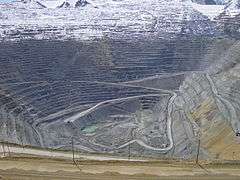
Copper was one of Rio Tinto's main products from its earliest days operating at the Rio Tinto complex of mines in Spain. Since that time, the company has divested itself from its original Spanish mines, and grown its copper-mining capacity through acquisitions of major copper resources around the world. The copper group's main active mining interests are Oyu Tolgoi mine in Mongolia, Kennecott Utah Copper in the United States, and Minera Escondida in Chile. Most of these mines are joint ventures with other major mining companies, with Rio Tinto's ownership ranging from 30% to 80%; only Kennecott is wholly owned. Operations typically include mining of ore through to production of 99.99% purified copper, including extraction of economically valuable byproducts.[73] Together, Rio Tinto's share of copper production at its mines totalled nearly 700,000 tonnes, making the company the fourth-largest copper producer in the world.[69]
Rio Tinto Copper continues to seek new opportunities for expansion, with major exploration activities at the Resolution Copper project in the United States, Winu in Australia, and Oyu Tolgoi underground mine in Mongolia. In addition, the company is seeking to become a major producer of nickel, with exploration projects currently underway in the United States and Indonesia.[73]
Although not the primary focus of Rio Tinto Copper's operations, several economically valuable byproducts are produced during the refining of copper ore into purified copper. Gold, silver, molybdenum, and sulphuric acid are all removed from copper ore during processing. Due to the scale of Rio Tinto's copper mining and processing facilities, the company is also a leading producer of these materials, which drive substantial revenues to the company.[73]
Sales of copper generated 8% of the company's 2008 revenues, and copper and byproduct operations accounted for 16% of underlying earnings.[24] Rio Tinto exclusively provided the metal to produce the 4,700 gold, silver, and bronze medals at the London 2012 Olympic and Paralympic Games. This was the second time Rio Tinto had done so for Olympic medals, having previously provided the metals for the Salt Lake City 2002 Winter Olympics.[74] Together, Rio Tinto's share of copper production at its mines totalled nearly 700,000 tonnes, making the company the fourth-largest copper producer in the world.[69] Rio Tinto also owns the naming rights to Rio Tinto Stadium located in nearby Sandy, Utah, and the home of the Major League Soccer team, Real Salt Lake.[75]
Aluminium
Rio Tinto consolidated its aluminium-related businesses into its aluminium product group (originally named Rio Tinto Alcan), formed in late 2007, when Rio Tinto purchased the Canadian company Alcan for $38.1 billion. Combined with Rio Tinto's existing aluminium-related assets, the new aluminium division vaulted to the world number-one producer of bauxite, alumina, and aluminium.[76] Aluminium division kept key leadership from Alcan, and the company's headquarters remain in Montreal.[27]
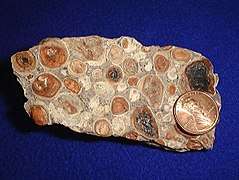
Rio Tinto divides its Aluminium operations into three main areas – bauxite, alumina and primary metal. The Bauxite and Alumina unit mines raw bauxite from locations in Australia, Brazil, and Africa. The unit then refines the bauxite into alumina at refineries located in Australia, Brazil, Canada, and France. The Primary Metal business unit's operations consist of smelting aluminium from alumina, with smelters located in 11 countries around the world. The Primary Metal group also operates several power plants to support the energy-intensive smelting process.[76]
The aluminium division has interests in seven bauxite mines and deposits, six alumina refineries and six speciality alumina plants, 26 aluminium smelters, 13 power plants, and 120 facilities for the manufacture of speciality products.[76] The acquisition of Alcan operations in 2007 substantially increased Rio Tinto's asset base, revenues, and profits: in 2008, 41% of company revenues and 10% of underlying earnings were attributable to the aluminium division.[24]
Uranium: Rio Tinto Energy
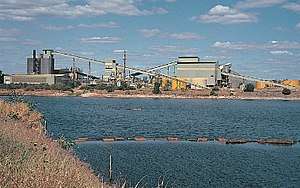
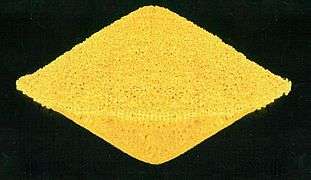
Rio Tinto Energy is a business group of Rio Tinto dedicated to the mining and sale of uranium. Rio Tinto's uranium operations are located at two mines: the Ranger Uranium Mine of Energy Resources of Australia and the Rössing Uranium Mine in Namibia. The company is the third-largest producer of uranium in the world. According to Rio Tinto's website, the company institutes strict controls and contractual limitations on uranium exports, limiting uses to peaceful, nonexplosive uses only. Such controls are intended to limit use of the company's uranium production to use as fuel for nuclear power plants only, and not for use in the production of nuclear weapons.[77] Rio Tinto Energy was responsible for 12% of revenues and 18% of underlying earnings in 2008.[24]
Diamonds: Rio Tinto Diamonds
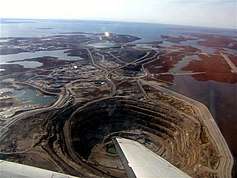
Rio Tinto Diamonds operates three diamond mines: the Argyle Diamond Mine in Western Australia (100% ownership), the Diavik Diamond Mine in the Northwest Territories of Canada (60% ownership), and the Murowa Diamond Mine located in Zimbabwe (78% ownership). Together, these three mines produce 20% of the world's annual production of rough diamonds,[78] making Rio Tinto the world's third-largest producer of mined diamonds.[71]
The diamond business unit's most advanced exploration project is the Falcon Project in Saskatchewan, Canada, where Rio Tinto owns 60% of the project in a joint venture with Star Diamond Corp. [79] Rio Tinto Diamonds generated 1% of revenues and earnings for Rio Tinto in 2008.[24]
Industrial minerals: Rio Tinto Minerals
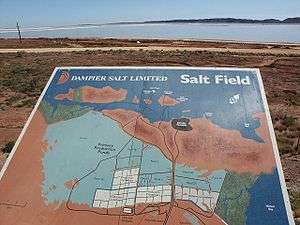
Rio Tinto Minerals is a diverse business group with mining and processing interest in borates, salt, and gypsum. Rio Tinto Borax, with operations in California, supplies nearly one-third of the world's annual demand for refined borates. The Minerals group is also majority owner of Dampier Salt, which produces over 9 million tonnes of salt and 1.5 million tonnes of gypsum annually from its three facilities in northwest Australia.[80] Rio Tinto Minerals accounted for 6% of company revenues, and contributed 3% to earnings in 2008.[24]
On 31 January 2010, the management of U.S. Borax locked out its hourly workforce, replacing the workers with nonunion workers and managers from other Rio Tinto operations. The 560 International Longshore and Warehouse Union Local 30 members immediately began a fireside vigil that garnered national and international labour attention.[81] ILWU filed several unfair labour practices against the company, including an illegal lock-out claim.[81]
Iron products and titanium: Rio Tinto Iron and Titanium
Titanium dioxide is mined at three locations in Canada, South Africa, and Madagascar, and refined at QIT-Fer et Titane's Canadian facilities.[82]
A media report in October 2013 revealed that the corporation plans to establish a fully automated railroad system for the transportation of iron ore across the Australian outback by 2015, thereby replacing the corporation's train drivers. The United Kingdom-based transport historian Christian Wolmar stated at the same time that the train drivers are most likely the highest-paid members of the occupation in the world at that time. As part of an overall strategy to increase profit margins, the corporation is spending US$518 million on the project.[83]
Technology: Rio Tinto's Development of Autonomous Technologies
Rio Tinto is a global leader in the development of autonomous technologies for use in the mining sector. As of 2018, Rio Tinto's fleet of 80 autonomous Komatsu vehicles had moved over 1 billion tonnes of ore and waste material in Western Australia's Pilbara Region.[84]
Furthermore, in late 2017 Rio Tinto announced funding for their Koodaideri Mine in Western Australia, which Rio Tinto had dubbed their "intelligent mine."[85]
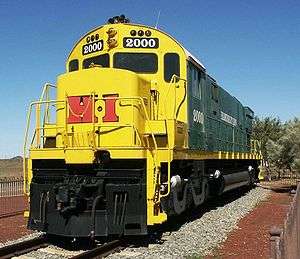
Financial results
Rio Tinto's revenues and earnings have grown substantially in 2003–2010, with one of the largest increases attributable to the company's acquisition of Alcan in 2007. Although operating margin is significantly impacted by the market prices of the various commodities it produces, Rio Tinto has remained profitable over its recent history and consistently generated positive cash flows from operations.[67][87][88]
| 2003 | 2004 | 2005 | 2006 | 2007 | 2008 | 2009 | 2010 | 2011 | 2012 | 2013 | 2014 | 2015 | 2016 | 2017 | 2018 | 2019 | |
|---|---|---|---|---|---|---|---|---|---|---|---|---|---|---|---|---|---|
| Gross sales revenue | 9,228 | 14,530 | 20,742 | 25,440 | 33,518 | 58,065 | 44,036 | 60,323 | 60,537 | 50,967 | 51,171 | 47,664 | 34,829 | 33,781 | 40,030 | 40,522 | 43,165 |
| Underlying profit before tax | 1,968 | 3,017 | 7,094 | 9,719 | 9,947 | 15,977 | 7,860 | 20,577 | 13,214 | 9,303 | 10,217 | 9,305 | 4,540 | 5,100 | 8,627 | 8,808 | 10,373 |
| Underlying net earnings | 1,382 | 2,272 | 4,955 | 7,338 | 7,443 | 10,303 | 6,298 | 13,987 | 5,826 | (2,990) | 3,665 | 6,527 | (866) | 4,617 | 8,762 | 13,638 | 8,010 |
| Cash flow from operations | 3,486 | 4,452 | 8,257 | 10,923 | 12,569 | 20,668 | 13,834 | 23,530 | 27,388 | 16,450 | 20,131 | 18,896 | 12,102 | 11,368 | 16,670 | 15,655 | 19,705 |
| Operating margin | 19% | 24% | 37% | 42% | 34% | 32% | 17% | 36% | 23% | 18% | 20% | 20% | 13% | 15% | 22% | 22% | 24% |
Public impact
Involvement with Axis powers in World War II
Rio Tinto's status as a mainly British-owned company, located in Spain and producing pyrites – an important material for military applications – created a complicated set of circumstances for the company's operation in the 1930s and 1940s. During the Spanish Civil War, the region in which Rio Tinto's mines were located came under the control of General Franco's Nationalists in 1936. However, Franco increasingly intervened in the company's operations, at times requisitioning pyrite supplies for use by Spain and its Axis allies Germany and Italy, forcing price controls on the company's production, restricting exports, and threatening nationalisation of the mines. Although company management (and indirectly, the British government) managed to counteract some of these efforts by Franco, much of the mine's pyrite production was channelled to Axis powers before and during World War II. Nonetheless, Franco's meddling caused the mine's production and profitability to fall precipitously during and after the war, leading the company to ultimately exit from its Spanish operations in 1954.[89]
Criticisms
African Iron Ore
In 2015, Rio Tinto was criticised by the Guinean government for the many mining delays at the local Simandou mine. Cece Noramou, government official said the government was “running out of patience”. President Alpha Conde himself said that "there have been people at Simandou for 15 years, 20 years, and they’ve never produced a ton of iron".[90]
In late 2016, Rio Tinto agreed to sell its stake in the Simandou iron ore mine to Chinalco and exit the deal. The deal was negotiated after the company's case against Vale and BSGR was dismissed at US District Court.[91]
Mental health
It has been widely reported that more can be done to improve the mental health of fly-in-fly-out (FIFO) workers in the mining industry.[92] In the Pilbara region of Western Australia it is reported that the state is experiencing high levels of suicide and people dealing with mental health issues.[93] As a major contributor to FIFO and residential employment in the region they have recognised mental health as an area that requires a strategy of the prevention and early intervention. To assist staff the company provides numerous resources to assist in maintaining a healthful mind. In 2017 Healthier Workplace WA provided the Iron Ore product group Gold recognition for their work in this field.[94][95]
Juukan Gorge
In May 2020, in order to expand an iron ore mine, Rio Tinto demolished a sacred cave in Juukan Gorge, Western Australia, which had evidence of 46,000 years of continual human occupation, and was considered the only inland site in Australia to show signs of continual human occupation through the last Ice Age.[96][97][98] Permission to destroy the site had been given in 2013 under the state Aboriginal Heritage Act 1972, which however has been under review since 2018.[99][100] The Puutu Kunti Kurrama and Pinikura peoples, who are the local land custodians, had fought the decision.[101] The destruction brought widespread criticism.[102][103]
On 31 May, Rio Tinto apologised for the distress caused.[104][105][106][107][108] According to 35 Aboriginal and Torres Strait Islander and human rights organisations, Rio Tinto's qualified apology is "far from an adequate response to an incident of this magnitude".[109]
On 9 June, Reconciliation Australia revoked its endorsement of Rio Tinto as partner in reconciliation action plans, defining the behaviour of the corporation a "breathtaking breach of a respectful relationship" which was "devastating for the Traditional Owners and robbed the world of a uniquely valuable cultural heritage site".[110] Also on 9 July, The Corporate Human Rights Benchmark (CHRB) and the World Benchmarking Alliance (WBA) condemned "the destruction of invaluable cultural heritage at Juukan Gorge", adding that this "incident is a severe adverse impact on cultural rights that has engendered extreme concern and outrage among the Puutu Kunti Kurrama and Pinikura traditional owners of the site as well as Aboriginal and Torres Strait Islander communities and their allies". The CHRB and WBA also called "on Rio Tinto to take appropriate action to carry out an independent investigation of the incident, involving affected stakeholders, to provide effective remedy and to prevent similar impacts in the future, in Australia and elsewhere". The statement was attached to the company's listing in the 2019 Benchmark Report.[111][112]
On 4 August, in its submission to a parliamentary inquiry looking at the destruction of the sacred rock caves, the company said it "missed opportunities" to alter its mine plan.[113] A dig in 2014 and a final report on the archaeological excavations in 2018 underlined the cultural and historical significance of the caves. Rio Tinto said it did not “clearly communicate” its plan for destroying the sacred site to the native land owners.[113]
Environment
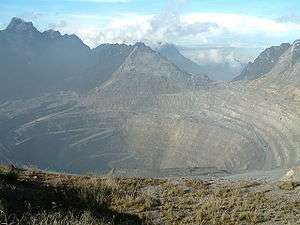
Mining
Rio Tinto has been widely criticised by environmentalist groups for its mining activities. Opposition to the company focuses on its mining methods due to environmental degradation, the company's coal operations for their contribution to global warming, and uranium operations for environmental and nuclear technology concerns. Perhaps the most significant environmental criticism to date has come from the government of Norway, which divested itself from Rio Tinto shares and banned further investment due to environmental concerns. Claims of severe environmental damages related to Rio Tinto's engagement in the Grasberg mine in Indonesia led the Government Pension Fund of Norway to exclude Rio Tinto from its investment portfolio. The fund, which is said to be the world's second-largest pension fund, sold shares in the company valued at 4.85 billion kr (US$855 million) to avoid contributing to environmental damages caused by the company.[114]
Exclusion of a company from the Fund reflects our unwillingness to run an unacceptable risk of contributing to grossly unethical conduct. The Council on Ethics has concluded that Rio Tinto is directly involved, through its participation in the Grasberg mine in Indonesia, in the severe environmental damage caused by that mining operation.[115]
Rio Tinto disputes the claims of environmental damage at the Grasberg mine, and states that the company has long maintained an excellent record on environmental issues.[116]
Carbon-dioxide emissions
According to The Guardian, Rio Tinto is one of the top 100 industrial greenhouse gas producers in the world, accounting for 0.75 percent of global industrial greenhouse gas emissions between 1988 and 2015.[117] In 2016, Rio Tinto estimated to have produced 32 million tonnes of carbon dioxide equivalent in its own climate change report.[118]
In March 2018, Rio Tinto was urged by institutional investors to set new rules requiring the company to adhere to the goals of the Paris Agreement to limit global warming to 1.5 degrees Celsius, including detailed plans to reduce scope 1 to 3 emissions.[119] Rio Tinto's top executives rejected the resolution, arguing that the company had made a lot of progress in reducing its greenhouse gas emissions and that appropriate plans were in place to deal with climate change.[120]
Rio also argued that scope 3 emissions, those of its customers, were beyond the firm's control.[121] Nevertheless, the corporation in September 2019 signed a partnership with Chinese steelmaker China Baowu Steel Group to find ways to reduce greenhouse gas emissions from steel making, in an attempt to tackle the scope 3 issue.[122]
Labour and human rights
Academic observers have also expressed concern[123] regarding Rio Tinto's operations in Papua New Guinea, which they allege were one catalyst of the Bougainville separatist crisis.[124] The British antipoverty charity War on Want has also criticised Rio Tinto for its complicity in the serious human rights violations which have occurred near the mines it operates in Indonesia and Papua New Guinea.[125]
On 31 January 2010, Rio Tinto locked out nearly 600 workers from a mine in Boron, California, USA.[126]
Rio Tinto was also accused of planning and funding the murder of RTI activist Shehla Masood in Bhopal, India. Apparently, she was protesting illegal diamond mining done by Rio Tinto in connivance with government officers. The case was, however, solved and no connection to Rio Tinto was established, though popular opinion still perceives them as the possible culprit.[127][128][129][130]
Rio Tinto is not, however, universally condemned for its ethical behaviour. The company has won an award for ethical behaviour, the Worldaware Award for Sustainable Development in 1993.[131] The award, although given by an independent committee, is sponsored by another multinational corporation (in this case, the sponsor was Tate and Lyle). Rio Tinto has, in turn, sponsored its own WorldAware award, the Rio Tinto Award for Long-term Commitment.[132] The British charity Worldaware ceased to exist in March 2005.[133] These awards, awarded to extractive industries which make some environmental commitments to deflect the more general criticisms of their operations, are referred to by corporate watchdog groups as "greenwashing".[134][135][136]
Corruption allegations
In China
In 2009, Chinese authorities began investigating allegations against Rio Tinto. These included bribing executives from 16 of China's biggest steel mill companies in order to get hold of secret information.[137] On 29 March 2010 four Rio Tinto employees including Australian citizen Stern Hu were found guilty of these charges and of accepting millions of dollars in bribes.[138] They were ordered to pay hundreds of thousands of dollars in fines, and sentenced to 7–14 years in jail.[139]
In Guinea
Rio Tinto has been embroiled in a number of corruption allegations over its acquisition of stakes in the Simandou iron ore mine in Guinea. The allegations center around the payment of a $10.5 million bribe to François de Combret, a French banking consultant who was a friend and adviser of President Alpha Condé.[140][141]
Rio Tinto launched an internal probe into the matter run by an independent law firm, and on 9 November 2016 announced it would report the findings to the United States Securities and Exchange Commission (SEC), the Serious Fraud Office (United Kingdom), the Australian Securities and Investments Commission, and the U.S. Justice Department. Rio Tinto also declared they would cooperate with all related investigations and fired two top executives in connection with the matter, one of whom was head of energy and minerals, Alan Davies,[142] who led the Simandou operation in 2011.[140] He was suspended after the investigators discovered suspicious emails discussing contractual payments from that year. Davies claimed that there were no grounds for the termination of his employment.[143]
The President of Guinea Alpha Condé denied having any knowledge of the illegal transactions, but recordings obtained by France24 prove otherwise.[144]
Sam Walsh, the retiring CEO of the company, had 80% of his pay withheld while the investigation continue.[145]
Also in early November 2016, Former mining minister of Guinea, Mahmoud Thiam, claimed that the head of Rio Tinto's operation in Guinea offered him a bribe in 2010 in order to win back control of the Simandou mine, and that his offer was supported by senior members of the company.[146]
Rio Tinto is currently facing at least 4 class action suits in the US demanding damages over the corruption allegations in Guinea. The suit states that Rio Tinto made “materially false and misleading statements” that “deceived” investors.[147]
In July 2017 the Serious Fraud Office (SFO) announced the launch of a fraud and corruption investigation into the company's business practices in Guinea.[148] Following the news of the investigation Rio Tinto shares in the US dropped by 1.4%.[149] The Australian Federal Police is also investigating the allegations.[150] Rio Tinto has announced it would cooperate fully. After the SFO investigation announcement, and amid a search for a new CEO, Rio Director John Varley was forced to resign from his role in the company.[151][152]
SEC Investigation
The U.S. Securities and Exchange Commission is investigating a $3 billion impairment charge against Rio Tinto regarding a coal deal they made in Mozambique. Rio acquired Riversdale Mining Ltd., an Australian coal mining company with significant interests in Mozambique,[153][154] in 2011 for $2.9 billion in an all-cash deal. Two years later they wrote-down the value of the assets by $3 billion. Following the impairment charge, which included an additional $11 billion in asset write-downs, Chief Executive Officer of Rio Tinto, Tom Albanese stepped down from his post and left the company. Rio later sold the assets for $50 million.[140]
See also
References
- Rio Tinto (4 December 2017). "Simon Thompson to succeed Jan du Plessis as chairman" (PDF) (Press release). Rio Tinto. Archived from the original (PDF) on 16 March 2018.
- "Annual Results 2019" (PDF). Rio Tinto. Retrieved 28 February 2020.
- "Our business". Rio Tinto Group. Archived from the original (PDF) on 10 April 2017. Retrieved 10 March 2019.
- Hotten, Russell (12 July 2007). "History of Rio Tinto". The Telegraph. London: Telegraph Media Group Limited. Retrieved 30 May 2020.
- "Rio Tinto sells its last Australian coalmine for $2.25bn". The Guardian (US ed.). New York City: Guardian News & Media Limited. Reuters. 28 March 2018. Retrieved 6 May 2020.
- "Rio Tinto Chartbook" (PDF). 2018.
- "Our Products". Rio Tinto web site. Rio Tinto Group. Archived from the original on 13 December 2010. Retrieved 11 March 2009.
- "Contact Us." Rio Tinto Group. Retrieved 9 April 2010. Archived 28 March 2010 at the Wayback Machine
- "Suburbs & Postcodes." City of Melbourne. Retrieved 5 April 2010.
- "Rio Tinto Plc Ord 10P". London Stock Exchange – Detailed Prices. London Stock Exchange. Archived from the original on 11 June 2009. Retrieved 11 March 2009.
- "S&P/ASX 200 Fact Sheet" (PDF). Standard & Poor's. Archived from the original (PDF) on 13 June 2011. Retrieved 11 March 2009.
- Bordenstein, Sarah. "Rio Tinto, Spain". Science Education Resource Center. Carleton College. Retrieved 3 March 2009.
- Harvey, Charles E. (1981). The Rio Tinto Company: An Economic History of a leading international mining concern, 1873–1954. Alison Hodge Publishers. pp. 10–11, 23, 52, 89, 202, 207–215, 314–324. ISBN 9780906720035.
- "Huelva Province – Rio Tinto". Andalucia.com. Andalucia.com. Retrieved 3 March 2009.
- "Clark, Punchard and Co". Grace's Guide to British Industrial History. Grace's Guide Ltd. Retrieved 9 March 2017.
- Stevens, Horace Jared (1908). The Copper Handbook. 8. Horace J. Stevens. p. 1457.
- "Who We Are: Timeline". Rio Tinto web site. Rio Tinto Group. 2009. Archived from the original on 19 December 2010. Retrieved 4 March 2009.
- "RTZ CRA United for Growth" (PDF). Rio Tinto Review. Rio Tinto Group. 2006. Archived from the original (PDF) on 27 March 2009. Retrieved 4 March 2009.
- Narelle Hooper (23 June 2000). "Rio Tinto sets its sights on North Ltd". Radio National. Australian Broadcasting Corporation. Retrieved 10 November 2008.
- Mark Drummond (16 June 2004). "Fortescue tries to prise open access to Pilbara railway line". Sydney Morning Herald. Retrieved 10 November 2008.
- Tanya Nolan (4 August 2000). "Rio Tinto's bid given the nod by ACCC". Radio National. Australian Broadcasting Corporation. Retrieved 10 November 2008.
- "Rio Tinto Completes Acquisition of North Limited". Business Wire. findarticles.com. 10 October 2000. Retrieved 10 November 2008.
- "Rio Tinto Chartbook" (PDF). Rio Tinto Group. March 2009. Archived from the original (PDF) on 15 July 2011. Retrieved 8 April 2009.
- "Rio Tinto Completes Acquisition of 100% of Alcan". Rio Tinto. 2007. Archived from the original on 18 January 2008. Retrieved 30 January 2008.
- Wu, Zijing; Campbell, Matthew; Paton, James (6 October 2014). "Rio Tinto Rejected Takeover Approach From Glencore". Bloomberg News.
- "Rio Tinto, Alcan reach US$38.1-billion merger deal". CTV.ca. 2007. Archived from the original on 14 July 2007. Retrieved 8 August 2007.
- Murphy, Mathew; Garnaut, John (8 July 2009). "Rio Tinto iron ore sales team arrested in China". Business Day. The Sydney Morning Herald. Sydney, Australia: Fairfax Network.
- Rio Tinto: 4 arrested in China on corruption charges – AGI Archived copy at WebCite (11 September 2009).
- Australia tries to limit damage over detention of Rio Tinto staff in China – Telegraph UK
- "Hu accused of bribery during negotiation – Yahoo!7 News". Archived from the original on 15 July 2009.
- Kwok, Vivian Wai-yin (10 August 2009). "The Iron Ore War:China claims Rio Tinto espionage cost it $100 billion". Forbes. Retrieved 12 September 2009.
- Editor, By Richard Fletcher, City. "Chinalco to team up with Rio Tinto on Simandou project". Telegraph.co.uk. Retrieved 14 April 2017.CS1 maint: extra text: authors list (link)
- "Rio Tinto and Chinalco subsidiary Chalco sign binding agreement for Simandou iron ore project joint venture". www.riotinto.com. 29 July 2010. Archived from the original on 14 April 2017. Retrieved 14 April 2017.
- Minerals Yearbook, 2010. Area Reports, International, Africa and the Middle East. Government Printing Office. 13 November 2012. p 20. ISBN 978-1-4113-3174-7.
- "Rio Tinto and Government of Guinea sign new agreement for Simandou iron ore project" (PDF). Rio Tinto Group. 22 April 2011. Archived from the original (PDF) on 14 April 2017. Retrieved 16 March 2018.
- "Rio Tinto claims control of Riversdale". 11 April 2011. Archived from the original on 11 June 2012. Retrieved 11 April 2011.
- White, Garry (11 April 2011). "Rio Tinto gets control of Riversdale". The Daily Telegraph.
- "Canada News - Rich potash resources struck at Acron and Rio Tinto joint venture project". canadanews.net. Archived from the original on 2 July 2014. Retrieved 21 March 2015.
- "Rio Tinto wins fight against Ivanhoe poison pill". 13 December 2011.
- "Rio Tinto to purge Ivanhoe Mines top tier". Sydney Morning Herald. 28 January 2012. Retrieved 25 March 2012.
- Glencore, Sumitomo buy Rio coal mine stake for $1 billion, International: Reuters, 2013
- Sarah Young (18 May 2015). "Rio Tinto to sell aluminum assets in $1 billion deal". Reuters. Retrieved 18 May 2015.
- "Our business - Rio Tinto". www.riotinto.com. 13 April 2013. Archived from the original on 10 April 2017. Retrieved 18 April 2016.
- "Rio Tinto Limited (RIO)". ASX Company Information. Australian Securities Exchange. Retrieved 11 March 2009.
- "Rio Tinto plc". Listings Directory. NYSE Euronext. Archived from the original on 21 April 2009. Retrieved 11 March 2009.
- Freed, Jamie (1 February 2008). "Chinese raid on Rio Tinto could thwart BHP". Sydney Morning Herald. Fairfax Digital. Archived from the original on 30 April 2008. Retrieved 10 April 2009.
- "BHP makes £120bn Rio bid approach". BBC News. 8 November 2007. Retrieved 8 November 2007.
- Keenan, Rebecca (25 November 2008). "BHP Withdraws $66 Billion Stock Offer for Rio Tinto". Bloomberg News. Archived from the original on 16 November 2008. Retrieved 10 April 2009.
- Espinoza, Javier (6 April 2009). "Rio Tinto on the Hunt for Cash". Forbes. Retrieved 7 April 2009.
- Treanor, Jill (1 February 2009). "Rio Tinto confirms talks over Chinese cash injection". The Guardian. London: Guardian News and Media Limited. Retrieved 7 April 2009.
- Shasha, Deng (3 April 2009). "Chinalco's roadblocks of investment in Rio Tinto Group decreasing". chinaview.cn. Xinhua News Agency. Archived from the original on 8 April 2009. Retrieved 7 April 2009.
- Denning, Liam (7 April 2009). "No Escape from China for Rio Tinto". Wall Street Journal. Retrieved 7 April 2009.
- "Rio Tinto Simandou". Retrieved 20 March 2010.
- "Rio Tinto joins up with Chinalco to explore for copper". Retrieved 9 February 2012.
- "Board of directors - Rio Tinto". www.riotinto.com. 20 April 2013. Retrieved 18 April 2016.
- "Management Overview". Rio Tinto web site. Rio Tinto. Archived from the original on 21 December 2010. Retrieved 5 March 2009.
- "Simon Thompson". Rio Tinto. 5 March 2018. Retrieved 10 March 2019.
- "David Constable". Rio Tinto. 10 February 2017. Retrieved 10 March 2019.
- "Megan Clark AC". Rio Tinto. 19 November 2014. Retrieved 10 March 2019.
- "Hinda Gharbi". Rio Tinto. Retrieved 6 May 2020.
- "Simon McKeon AO". Rio Tinto. Retrieved 6 May 2020.
- "Simon Henry". Rio Tinto. 13 March 2017. Retrieved 10 March 2019.
- "Jennifer Nason". Rio Tinto. 13 March 2017. Retrieved 10 March 2019.
- "Sam Laidlaw". Rio Tinto. 10 February 2017. Retrieved 10 March 2019.
- "Michael L'Estrange AO". Rio Tinto. Retrieved 10 March 2019.
- "Rio Tinto Preliminary Results 2008" (PDF). Archived from the original (PDF) on 27 March 2009. Retrieved 8 March 2009.
- "Iron Ore Fact Sheet" (PDF). Rio Tinto Group. Archived from the original (PDF) on 30 September 2011. Retrieved 11 March 2009.
- "Copper Fact Sheet" (PDF). Rio Tinto Group. Archived from the original (PDF) on 27 March 2009. Retrieved 11 March 2009.
- "Molybdenum". Roskill Metals and Minerals Reports. Roskill Information Services. 2007. Archived from the original on 4 November 2008. Retrieved 11 March 2009.
- Krawitz, Avi (15 January 2009). "Rio Tinto 4Q08 Diamond Production −12%". Diamonds.net News. Diamonds.net. Retrieved 11 March 2009.
- "Iron Ore". Rio Tinto. Retrieved 6 May 2020.
- "Copper". Rio Tinto web site. Rio Tinto Group. Archived from the original on 10 September 2008. Retrieved 6 May 2020.
- "We're helping to produce the London 2012 medals". Rio Tinto web site. Rio Tinto Group. Archived from the original on 14 May 2013. Retrieved 21 March 2012.
- "Rio Tinto Stadium partners with Auric Solar to install largest solar energy offset in North American pro sports venues". RSL Communications. 7 April 2015. Retrieved 11 April 2017.
- "Alumina, Aluminium and Bauxite". Rio Tinto web site. Rio Tinto Group. Archived from the original on 1 September 2010. Retrieved 12 March 2009.
- "Uranium". Rio Tinto web site. Rio Tinto Group. Archived from the original on 19 December 2010. Retrieved 12 March 2009.
- "Rio Tinto's Diamond Mines in Australia,Africa and Canada". Rio Tinto Diamonds web site. Rio Tinto Group. Retrieved 13 March 2009.
- "Rio Tinto Projects". Rio Tinto Diamonds web site. Rio Tinto Group. Retrieved 20 February 2020.
- "Dampier Salt web site". Archived from the original on 24 November 2009. Retrieved 12 March 2009.
- "Borax Miners".
- "QIT-Fer et Titane". QIT-Fer et Titane web site. QIT-Fer et Titane. Archived from the original on 15 July 2011. Retrieved 11 March 2009.
- Elisabeth Behrmann (3 October 2013). "Rio Replacing Train Drivers Paid Like U.S. Surgeons". Bloomberg L.P. Retrieved 3 October 2013.
- McPherson, Sally. "Rio Tinto's Autonomous Trucks Have Now Moved 1 Billion Tonnes of Material". Retrieved 26 November 2018.
- Nugent, Ollie. "Rio Tinto has approved funding for its 'intelligent' Pilbara Mine". Retrieved 26 November 2018.
- Business Editors (2 July 2001). "Robe and Hamersley to Share Pilbara Rail Infrastructure, Says Rio Tinto". Business Wire. Business Wire. Archived from the original on 29 August 2008. Retrieved 13 March 2009.
- "Preliminary Results 2009" (PDF). Riotinto.com. 19 April 2012. Archived from the original (PDF) on 30 September 2011. Retrieved 24 April 2012.
- "Annual Report 2015" (PDF). Retrieved 26 March 2016.
- Kutney, Dr. Gerald (2007). Sulfur: History, Technology, Applications & Industry. ChemTec Publishing. p. 260. ISBN 9781895198379. Retrieved 9 April 2009.
- "Rio Runs Out of Guinea Goodwill as Giant Iron-Ore Mine Lags". Bloomberg.com. 13 October 2015. Retrieved 14 April 2017.
- "Chinese buy world's largest mining project | MINING.com". MINING.com. 28 October 2016. Retrieved 14 April 2017.
- "The challenge of mental health in the mining industry". Headsup.org.au. 31 March 2015. Retrieved 10 March 2019.
- "Pilbara population and health snapshot" (PDF). Retrieved 10 March 2019.
- "Mental health matters". Rio Tinto. 8 March 2018. Retrieved 10 March 2019.
- Kristy Campbell. "Rio Tinto". Healthier Workplace WA. Retrieved 10 March 2019.
- How significant does something have to be, document by the Council of Australasian Museum Directors, posted on May 28th, 2020.
- "A 46,000-Year-Old Aboriginal Site Was Just Deliberately Destroyed in Australia". Science Alert. 28 May 2020. Retrieved 31 May 2020.
- "Mining firm Rio Tinto sorry for destroying Aboriginal caves". BBC News. 31 May 2020.
- Aboriginal heritage legislation to be reviewed, by Government of Western Australia, posted on the 9 March 2018. Retrieved on 18 June 2020.
- Review of the Aboriginal Heritage Act 1972. Fact sheet: Timeline, by the Department of Planning, Lands and Heritage, of the Government of Western Australia. Retrieved on 18 June 2020.
- Watson, Angus; Westcott, Ben (1 June 2020). "Miner apologizes for blowing up 46,000-year-old sacred site". CNN. Retrieved 1 June 2020.
- "Rio Tinto blasts 46,000-year-old Aboriginal site to expand iron ore mine | Indigenous Australians". The Guardian. 26 May 2020. Retrieved 27 May 2020.
- "Rio Tinto's claim rejected as 'outrageous' after Aboriginal sacred site destroyed". SBS News. 27 May 2020. Retrieved 31 May 2020.
- Wahlquist, Calla. "Leaked tape reveals Rio Tinto does not regret destroying 46,000-year-old Aboriginal rock shelter to expand mine". Guardian News. Retrieved 16 June 2020.
- Watson, Angus. "Rio Tinto: Miner apologizes for blowing up 46,000-year-old sacred indigenous site in Western Australia - CNN". Edition.cnn.com. Retrieved 1 June 2020.
- Statement on Juukan Gorge, issued by Rio Tinto on the 31st of May 2020.
- Statement on Juukan Gorge, issued by Rio Tinto on 12 June 2020.
- Rio Tinto responds to allegations they’re ‘not sorry’ for Juukan Gorge destruction 17 June 2020
- Joint letter to the Corporate Human Rights Benchmark, by 35 Aboriginal and Torres Strait Islander and human rights organisations, sent on 8 July 2020.
- Statement on Rio Tinto, issued by Reconciliation Australia on the 9 June 2020.
- "CHRB response to the destruction of a 46,000-year-old Aboriginal heritage site by Rio Tinto at Juukan Gorge in Western Australia on 24 May 2020", statement issued by The Corporate Human Rights Benchmark on the 9 July 2020.
- Australian Indigenous Organisations Call for Rio Tinto to Be Stripped of Its Status as a Human Rights Leader, posted by Global Citizen on 13 July 2020.
- Hume, Neil; Smyth, Jamie (4 August 2020). "Rio Tinto missed chances to prevent demolition of sacred rock caves". Financial Times.
- Norwegian Ministry of Finance (9 September 2008). "The Government Pension Fund divests its holdings in mining company".
- MacAlister, Terry (9 September 2008). "Ethical business: Norway ejects mining giant Rio from its pension portfolio". The Guardian. UK. Retrieved 10 September 2008.
- "Norway blacklists miner Rio Tinto". BBC News. 10 September 2008. Retrieved 9 April 2009.
- Riley, Tess (10 July 2017). "Just 100 companies responsible for 71% of global emissions, study says". The Guardian. ISSN 0261-3077. Retrieved 25 September 2019.
- "Climate change report" (PDF). Rio Tinto. Archived from the original (PDF) on 23 June 2017.
- Reuters Editorial. "Rio asks shareholders to vote against emissions resolution". U.S. Retrieved 25 September 2019.
- Gray, Darren (2 May 2018). "Rio Tinto delivers strong defence of its climate change stance". The Sydney Morning Herald. Retrieved 25 September 2019.
- "Rio rebuffs climate investor push". Financial Times. 18 March 2019.
- Butler, Ben (25 September 2019). "Rio Tinto strikes deal with big Chinese customer to find ways to cut emissions". The Guardian. ISSN 0261-3077. Retrieved 25 September 2019.
- Regan, Anthony J. (2014). "Bougainville: Large-scale Mining and Risks of Conflict Recurrence". 10. Security Challenges: 71–96. JSTOR 26467882. Cite journal requires
|journal=(help) - See Lea, David (1999). "Corporate and Public Responsibility, Stakeholder Theory and the Developing World". Business Ethics: A European Review. 8 (3): 151–162. doi:10.1111/1467-8608.00143.
- Curtis, Mark (November 2007). "Fanning the Flames" (PDF). War on Want. Archived from the original (PDF) on 22 December 2009. Retrieved 10 April 2009.
- "Locked-out Rio Tinto borax miners in U.S. get support". Reuters. 25 February 2010. Retrieved 24 February 2010.
- "Shehla Masood case solved: Twitterati slams Congress". dailybhaskar. 29 February 2012.
- "Letters by Shehla Masood on Illegal mining".
- ""I Fear For My Life, But I'll Go On" | Outlook India Magazine". Outlookindia.com.
- "RTI activist shot dead".
- "Tate and Lyle Award for Sustainable Development". Worldaware. 1993. Archived from the original on 6 January 2009. Retrieved 10 April 2009.
- "The Rio Tinto Award for Long-Term Commitment". Worldaware. 1999. Archived from the original on 23 July 2001. Retrieved 10 April 2009.
- "About Worldaware". Worldaware.org.uk. Archived from the original on 17 February 2012. Retrieved 24 April 2012.
- Client Earth. "Rio Tinto's greenwash challenged in first big test of UK's company reporting regulator". Archived from the original on 14 April 2013. Retrieved 8 April 2011.
- Campbell, Logan (28 October 2008). "Rio Tinto greenwashing bad record". The Daily Utah Chronicle. Retrieved 9 April 2011.
- Bruno, Kenny. "The UN's Global Compact, Corporate Accountability and the Johannesburg Earth Summit". CorpWatch. Retrieved 1 April 2011.
- "Rio Tinto bribery case advances in China - CNN.com". Retrieved 14 April 2017.
- Barboza, David (29 March 2010). "Stiff Sentences Given to Rio Tinto Employees in China". The New York Times. ISSN 0362-4331. Retrieved 14 April 2017.
- "TRACE Compendium - RIO TINTO GROUP". www.traceinternational.org. Retrieved 14 April 2017.
- "SEC Said to Probe Rio Tinto on Mozambique Deal Impairments". Bloomberg.com. 28 November 2016. Retrieved 14 April 2017.
- "French claims Rio's consultant working 'hand in hand' with officials in Guinea". Financial Review. 2 December 2016. Retrieved 14 April 2017.
- Samb, Sonali Paul and Saliou. "Rio Tinto suspends senior executive after Guinea investigation". Reuters UK. Retrieved 14 April 2017.
- "Sacked Rio Tinto exec hits back over Guinea bribery scandal". The Telegraph. Retrieved 14 April 2017.
- "Audio recordings drag Guinea president into mine bribery scandal - France 24". France 24. 1 December 2016. Retrieved 14 April 2017.
- Pash, Chris (3 March 2017). "Rio Tinto's retiring CEO Sam Walsh is having problems with his bonus". Business Insider Australia. Retrieved 14 April 2017.
- "Rio Tinto Offered Bribe for Mine, Ex-Guinea Minister Says". Bloomberg.com. 18 November 2016. Retrieved 14 April 2017.
- "Subscribe | theaustralian". www.theaustralian.com.au. Retrieved 14 April 2017.
- "UK's SFO says opens investigation into Rio Tinto Group". Reuters. 24 July 2017. Retrieved 3 January 2018.
- Staff; Reuters (25 July 2017). "SFO says it is investigating Rio Tinto over Guinea operations". The Guardian. ISSN 0261-3077. Retrieved 3 January 2018.
- AFP. "UK Serious Fraud Office probes Rio Tinto Guinea project". The Citizen. Retrieved 3 January 2018.
- "Subscribe to read". Financial Times. Retrieved 3 January 2018.
- Knight, Elizabeth (22 June 2017). "Rio Tinto's governance a fiasco as director charged with fraud". The Sydney Morning Herald. Retrieved 3 January 2018.
- "Riversdale Resources Limited". www.rivresources.com. Retrieved 14 April 2017.
- "Mozambique: Riversdale mining company to mine 20 million tonnes of coal per year in Tete province". Macauhub. 18 May 2009. Retrieved 14 April 2017.
Further reading
- Avery, David (1974). Not on Queen Victoria's Birthday; the Story of the Rio Tinto Mines. London: Collins. OCLC 1086684067.
External links
| Wikimedia Commons has media related to Rio Tinto (company). |